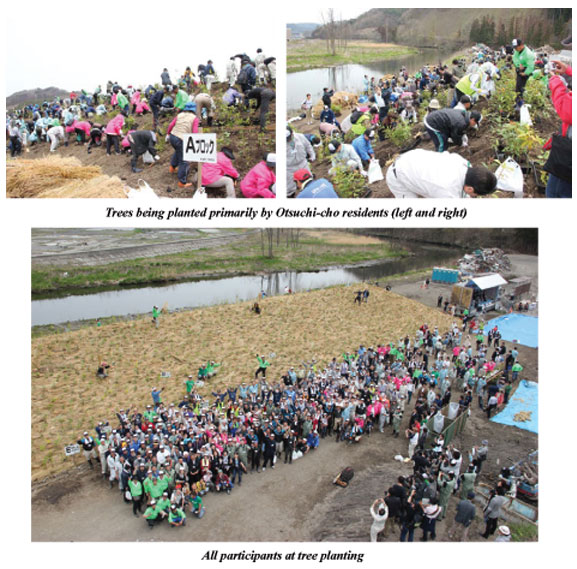News Release
Yokohama Rubber Holds Tree Planting in Otsuchi-cho Using Disaster Debris under its Yokohama Forever Forest Project
Around 550 Residents and Other Participants Plant Almost 3,400 Trees
2012.May.17
- Management relation
- Sustainability relation
Tokyo - The Yokohama Rubber Co., Ltd., announced today that on April 30 it carried out a tree planting under its Yokohama Forever Forest Project in Otsuchi-cho, Kamihei-gun, Iwate Prefecture. The plan by Otsuchi-cho as part of its earthquake-and-tsunami recovery program is to create "Forests That Protect Lives." Supporting that plan, the company carried out the model planting. Five hundred forty-three participants, including some 330 Otsuchi-cho residents, planted 3,391 broad-leaved evergreen seedlings indigenous to the local area. Together with Otsuchi Mayor Yutaka Ikarigawa and Dr. Akira Miyawaki, plant ecologist, guests included former prime minister Morihiro Hosokawa, current Minister Goshi Hosono of the Environment, Mr. Koichiro Katsumata, member of the House of Representatives, Mr. Ukyo Katayama, former F1 driver, and Mr. Yuko Ishikawa, Executive Managing Officer of Takenaka Civil Engineering & Construction Co., Ltd. From Yokohama Rubber, 111 people attended at the event, including Chairman and CEO Tadanobu Nagumo, President Hikomitsu Noji and 55 employee volunteers.
Having suffered massive damage from the Great East Japan Earthquake, Otsuchi-cho is pursuing the concept of creating "Forests That Protect Lives" as part of its recovery program – creating forests along the coast that will provide not only strength against tsunami, but places for recreation and relaxation for citizens. In addition, various other positive effects can also be expected. For example, using disaster debris to build the mounds on which the trees will be planted will facilitate debris disposal. Yokohama Rubber supported the concept and built an experimental mound 50 meters long and about 15 meters wide, utilizing earth, sand and woody debris, including fallen trees and driftwood.
Using disaster debris for afforestation is advocated by Dr. Akira Miyawaki, who calls for creation of forests along the 300-kilometer Pacific coast of the Tohoku region. According to his idea, planting trees indigenous to the local area (potential natural vegetation) can create "genuine" or "native" forests that will be able to withstand tsunami or fire. He also says effective use of debris in the mounds created for planting would be a positive contribution to solving the disposal problem.
Under the guidance of Dr. Miyawaki, Yokohama Rubber has been carrying out its "Yokohama Forever Forest" project for the past five years. A total of 500,000 trees will be planted at all Yokohama Rubber Group production facilities in and outside Japan by 2017, when the company will mark its 100th anniversary. As of April this year, approximately 240,000 trees had been planted. The company held this tree planting in support of creating "genuine" or "native" forests as part of restoration from the Great East Japan Earthquake, as advocated by Dr. Miyawaki.

Summarized Messages from Selected Participants
Otsuchi Mayor Yutaka Ikarigawa
Debris in Otsuchi-cho is not just disaster waste. It is part of our citizens' lives, and, in a sense, part of our inheritance from the dead. Forests created from such debris will provide repose for their souls. This forest is part of our effort to not let the memories of the disaster fade away in the years and generations to come.
Former Prime Minister Morihiro Hosokawa
The biggest current issue in the affected area is disposal of debris. Using it as a resource for restoration, instead of viewing it as a nuisance, can be one of the keys to a breakthrough. Assembling interested people, Dr. Miyawaki and I are promoting a "Great Wall of Forest Project (tentative name)." We propose building mounds 20-30 meters high with debris along the 300-kilometer Pacific coast of Tohoku and planting 90-100 million shii (castanopsis), kashi (Japanese oak) and tabu (machilus) trees over a period of ten years.
Minister Goshi Hosono of the Environment
The government received a proposal from Yokohama Rubber and Otsuchi-cho for effective use of disaster debris in forests offering comfort to the spirits of the dead as well as disaster-prevention for residents. The government in turn saw their idea as a good way for people in the affected area to participate in the recovery effort with respect for victims as well as to help dispose of debris more quickly. The government is now working on ways to deal with existing regulations. Today's tree planting is not just the start of a forest for "repose of souls" for Otsuchi-cho. Under the initiative of Prime Minister Yoshihiko Noda, a "Green Ties Restoration Project (tentative name)" will soon start on the Sendai Plain.
Yokohama's Chairman and CEO Tadanobu Nagumo
In its "Medium-Range Management Plan: Grand Design 100," issued in 2006 and to be achieved by 2017 when the company will mark its 100th anniversary, Yokohama Rubber included in its basic policies the “assertion of world-class strengths in technologies for protecting the environment.” At around that time, I met with plant ecologist Dr. Akira Miyawaki and was impressed by his concept of creating "genuine" forests. Since 2007, Yokohama has been planting trees at its production facilities both in and outside Japan. After the Great East Japan Earthquake, Dr. Miyawaki swiftly called for creating forests using disaster debris. We want to help him in a meaningful way.
Yokohama's President Hikomitsu Noji
We are planting trees around the world and they have been growing at a rate of a meter or two a year, particularly in Southeast Asia where it is hot. In Otsuchi-cho, the hope is for a meter of growth per year because of the climate. Still, it will be a wonderful forest in ten years. Wanting to do whatever it can to help in the restoration, Yokohama Rubber will continue its various activities, including dispatching employee volunteers and furnishing goods and supplies – as you see here today.



